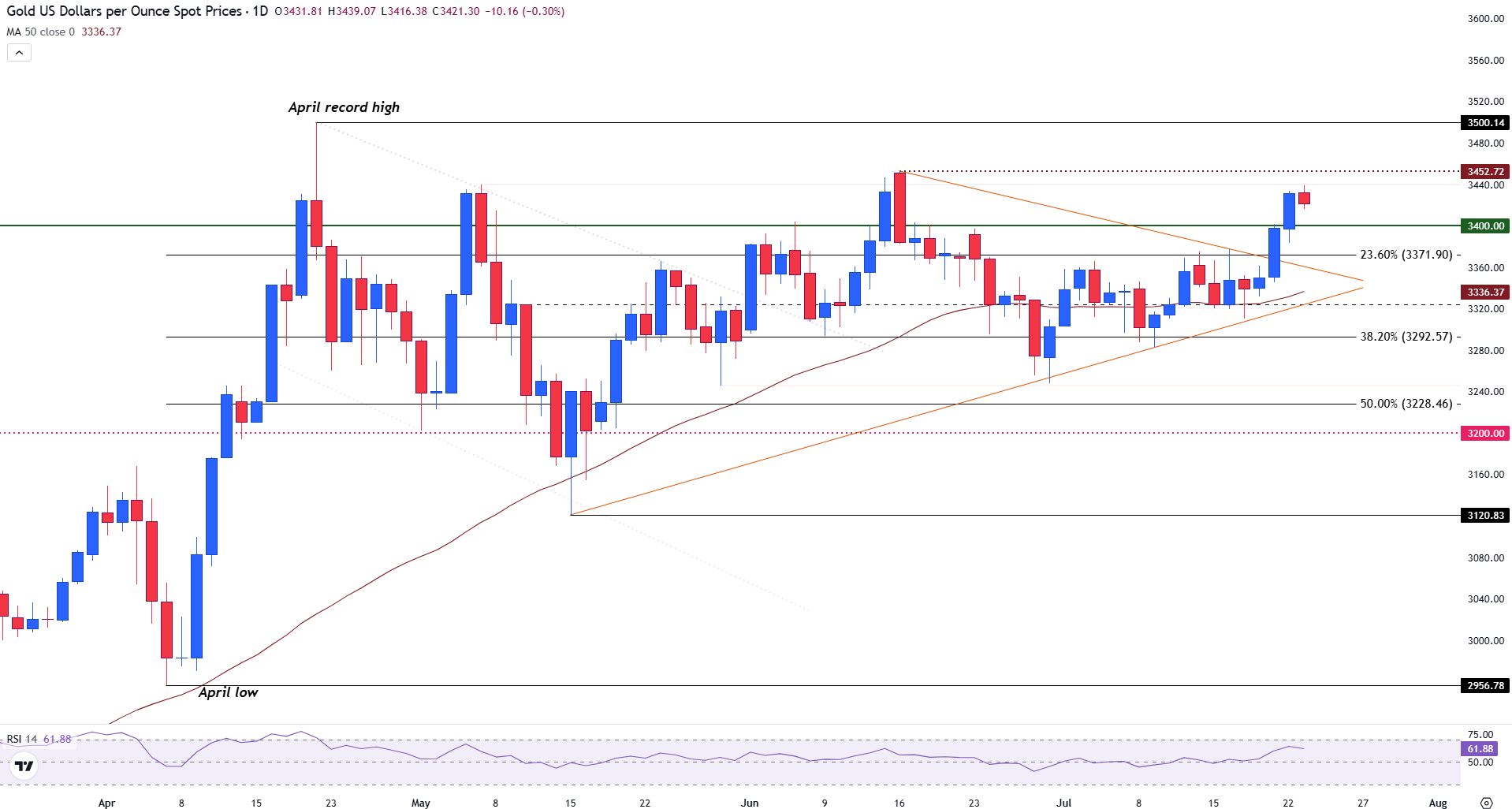Gold rally pauses as US-Japan deal offers temporary relief, Fed pressure and EU risks linger
- Gold rally pauses on Wednesday as US-Japan agreement offers temporary relief from trade tensions.
- Gold retains its safe-haven appeal amid ongoing uncertainty from the Fed and unresolved tariff risks, limiting bullion losses.
- XAU/USD consolidates near five-week highs, holds firm above $3,400.
Gold (XAU/USD is undergoing a modest pullback on Wednesday, as markets assess the implications of a United States (US)–Japan trade agreement and remain cautious ahead of further developments in the European Union (EU)–US negotiations.
Despite the correction, XAU/USD is holding above the $3,400 mark, supported by lingering tariff risks and broader policy uncertainty.
Attention now turns to incoming US economic data for near-term direction. The June Existing Home Sales report, on Wednesday, will provide insight into consumer resilience and housing market trends amid elevated interest rates.
Existing home sales are a key economic indicator, offering a snapshot of housing demand and overall economic momentum. With over 90% of residential transactions involving existing properties, the data reflects shifts in consumer confidence, mortgage affordability, and broader financial conditions. For June, sales are forecast at 4.01 million units, slightly down from 4.03 million in May, signaling a potential cooling in the market amid elevated borrowing costs.
Gold consolidates as US-Japan trade deal improves market mood
US President Donald Trump announced on Wednesday that a “massive deal” had been reached with Japan, outlining key terms in a Truth Social post.
The agreement includes a reduced 15% reciprocal tariff on Japanese goods, down from a proposed 25%. The deal is also expected to entail plans for $550 billion in Japanese investment and expanded US access to Japan’s agricultural and automotive markets.
However, Japan’s Prime Minister Shigeru Ishiba adopted a more measured tone, noting that the deal’s terms still require thorough review. “As for what to make of the outcome, I am not able to discuss it until we carefully examine the negotiations and the agreement,” Ishiba said.
While this development briefly eased pressure on Gold bears, the absence of a formal agreement and clarity surrounding sector-specific tariffs has kept investors cautious.
Daily digest market movers: Gold retains its appeal amid ongoing Fed uncertainty and unresolved tariff risks
- At the same time, EU-US trade talks remain unresolved, with less than two weeks until the August 1 tariff deadline. If no agreement is reached, the US may impose broad-based tariffs of up to 30% on EU imports. This has prompted the European Union to prepare retaliatory measures targeting key US exports, including digital services and aerospace products.
- Apart from trade talks, policy uncertainty and mounting pressure on the Federal Reserve (Fed) to cut rates have put pressure on Yields, limiting gains in the US Dollar. US President Trump has consistently and very publicly called for the Fed to dramatically lower interest rates, often stating they should be at 1% or even lower.
- In a meeting with Philippine President Ferdinand Marcos on Tuesday, Trump stated that Powell has "done a bad job, but he's going to be out pretty soon." Comments from Treasury Secretary Scott Bessent also suggested that it might be time to "examine the entire institution and whether they've been successful.” He proposed a framework for the Fed's non-monetary functions due to concerns over "mission creep" and building renovation overruns.
- Some critics also point to the Fed's practice of paying interest on bank reserves as a "perverse" structure that subsidizes banks and has led to the Fed operating at a loss.
- With the Fed currently in a blackout period ahead of the July 30 rate decision, criticism from Trump and concerns surrounding Fed Independence have enhanced the appeal of Gold.
Gold technical analysis: XAU/USD consolidates near five-week highs, holds firm above $3,400
Gold is trading around $3,421 at the time of writing on Wednesday, having pulled back slightly from its five-week intraday high of $3,439.
The Relative Strength Index (RSI) is currently hovering around 63 on the daily chart, indicating that momentum remains positive but is not yet overbought.
If bulls maintain control, a retest of the June swing high of $3,452 appears likely, with potential for further upside toward the all-time high and psychological $3,500 level.
On the downside, immediate support is seen at the $3,400 round level, followed by the 23.6% Fibonacci retracement of the April low-high move at $3,371 and the 50-day SMA at $3,336. A break below the triangle apex and the 38.2% Fibonacci level at $3,292 would invalidate the near-term bullish structure.

Gold daily chart
Gold FAQs
Gold has played a key role in human’s history as it has been widely used as a store of value and medium of exchange. Currently, apart from its shine and usage for jewelry, the precious metal is widely seen as a safe-haven asset, meaning that it is considered a good investment during turbulent times. Gold is also widely seen as a hedge against inflation and against depreciating currencies as it doesn’t rely on any specific issuer or government.
Central banks are the biggest Gold holders. In their aim to support their currencies in turbulent times, central banks tend to diversify their reserves and buy Gold to improve the perceived strength of the economy and the currency. High Gold reserves can be a source of trust for a country’s solvency. Central banks added 1,136 tonnes of Gold worth around $70 billion to their reserves in 2022, according to data from the World Gold Council. This is the highest yearly purchase since records began. Central banks from emerging economies such as China, India and Turkey are quickly increasing their Gold reserves.
Gold has an inverse correlation with the US Dollar and US Treasuries, which are both major reserve and safe-haven assets. When the Dollar depreciates, Gold tends to rise, enabling investors and central banks to diversify their assets in turbulent times. Gold is also inversely correlated with risk assets. A rally in the stock market tends to weaken Gold price, while sell-offs in riskier markets tend to favor the precious metal.
The price can move due to a wide range of factors. Geopolitical instability or fears of a deep recession can quickly make Gold price escalate due to its safe-haven status. As a yield-less asset, Gold tends to rise with lower interest rates, while higher cost of money usually weighs down on the yellow metal. Still, most moves depend on how the US Dollar (USD) behaves as the asset is priced in dollars (XAU/USD). A strong Dollar tends to keep the price of Gold controlled, whereas a weaker Dollar is likely to push Gold prices up.

